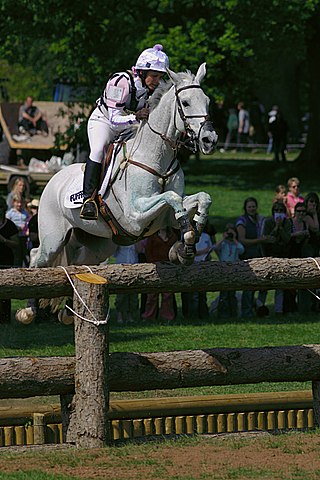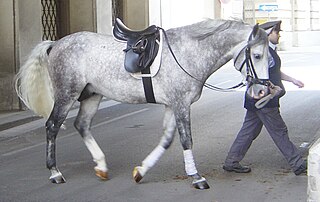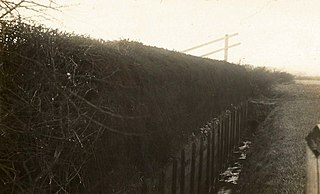Show jumping is a part of a group of English riding equestrian events that also includes eventing, hunters, and equitation. Jumping classes are commonly seen at horse shows throughout the world, including the Olympics. Sometimes shows are limited exclusively to jumpers. Sometimes jumper classes are offered in conjunction with other English-style events. Sometimes, show jumping is but one division of a very large, all-breed competition that includes a very wide variety of disciplines. Jumping classes may be governed by various national horse show sanctioning organizations, such as the United States Equestrian Federation or the British Showjumping Association. International competitions are governed by the rules of the International Federation for Equestrian Sports.

Eventing is an equestrian event where a single horse and rider combine and compete against other competitors across the three disciplines of dressage, cross-country, and show jumping. This event has its roots in a comprehensive cavalry test that required mastery of several types of riding. The competition may be run as a one-day event (ODE), where all three events are completed in one day or a three-day event (3DE), which is more commonly now run over four days, with dressage on the first two days, followed by cross-country the next day and then show jumping in reverse order on the final day. Eventing was previously known as Combined Training, and the name persists in many smaller organizations. The term "Combined Training" is sometimes confused with the term "Combined Test", which refers to a combination of just two of the phases, most commonly dressage and show jumping.

Equestrianism, commonly known as horse riding or horseback riding, includes the disciplines of riding, driving, and vaulting. This broad description includes the use of horses for practical working purposes, transportation, recreational activities, artistic or cultural exercises, and competitive sport.

Collection occurs when a horse's center of gravity is shifted backwards. Energy is directed in a more horizontal trajectory with less forward movement. Biomechanical markers include: increased flexion in the lumbo-sacral joint, stifle, and hocks of the horse; increased engagement of the thoracic sling muscles resulting in the withers rising relative to the horse's scapula; and reduced ranges of limb protraction–retraction.

Cross country equestrian jumping is an endurance test that forms one of the three phases of the sport of eventing; it may also be a competition in its own right, known as hunter trials or simply "cross-country", although these tend to be lower-level, local competitions.

English saddles are used to ride horses in English riding disciplines throughout the world. The discipline is not limited to England, the United Kingdom in general or other English-speaking countries. This style of saddle is used in all of the Olympic and International Federation for Equestrian Sports (FEI) equestrian disciplines, except for the newly approved FEI events of equestrian vaulting and reining. Most designs were specifically developed to allow the horse freedom of movement, whether jumping, running, or moving quickly across rugged, broken country with fences. Unlike the western saddle or Australian Stock Saddle, there is no horn or other design elements that stick out above the main tree of the saddle.

Equitation is the art or practice of horse riding or horsemanship.

Becher's Brook is a fence jumped during the Grand National, a National Hunt horse race held annually at Aintree Racecourse near Liverpool, England. It is jumped twice during the race, as the 6th and 22nd fence, as well as on four other occasions during the year. It has always been a notorious and controversial obstacle, because of the size and angle of the 6-foot-9-inch (2.06 m) drop on the landing side. Some jockeys have compared it to "jumping off the edge of the world."
The equestrian events at the 1972 Summer Olympics in Munich included show jumping, dressage and eventing. All three disciplines had both individual and team competitions. The equestrian competitions were held at 3 sites: an existing equestrian facility at Riem for the individual show jumping and eventing competitions, the Olympic Stadium in Munich for the Nations Cup, and Nymphenburg, a Baroque palace garden, for the sold-out dressage. 179 entries, including 31 women, competed from 27 countries: Argentina, Australia, Austria, Belgium, Bolivia, Bulgaria, Brazil, Canada, Chile, Denmark, German Democratic Republic (GDR), France, Federal Republic of Germany (FRG), Great Britain, Hungary, Ireland, Italy, Japan, Mexico, the Netherlands, Poland, Portugal, Soviet Union, Spain, Sweden, Switzerland, and the USA. The youngest participant was Kurt Maeder from Switzerland at 19 years old, while the oldest rider was Lorna Johnstone from Great Britain at 70 years old.

The Hunter division is a branch of horse show competition that is judged on the horse's performance, soundness and when indicated, conformation, suitability or manners. A "show hunter" is a horse that competes in this division.

Hunt seat is a style of forward seat riding commonly found in North American horse shows. Along with dressage, it is one of the two classic forms of English riding. The hunt seat is based on the tradition of fox hunting. Hunt seat competition in North America includes both flat and over fences for show hunters, which judge the horse's movement and form, and equitation classes, which judge the rider's ability both on the flat and over fences. The term hunt seat may also refer to any form of forward seat riding, including the kind seen in show jumping and eventing.

Equestrian sports were first included in the Olympic Games in the Summer Olympics of 1900 in Paris. They were again included in 1912, and have been included in every subsequent edition of the Games. The Olympic equestrian disciplines are dressage, eventing, and show-jumping. In each discipline, both individual and team medals are awarded. Women and men compete on equal terms.

Captain Federico Caprilli was an Italian cavalry officer and equestrian who revolutionized the jumping seat. His position, now called the "forward seat," formed the modern-day technique used by all jumping riders today.

Bucking is a movement performed by an animal in which it lowers its head and raises its hindquarters into the air while kicking out with the hind legs. It is most commonly seen in herbivores such as equines, cattle, deer, goats, and sheep. Most research on this behavior has been directed towards horses and cattle.

The Red Hills Horse Trials is held in Tallahassee, in the U.S. state of Florida and is one of the equestrian world's top events. It is an annual major eventing competition held by the United States Eventing Association, Area III and the 16th event held in Area III consisting of Dressage, Cross-country, and Show jumping.

The jumping position is a position used by equestrians when jumping over an obstacle. It usually involves what is known as the "forward seat" or "2 point" because the rider's legs provide two points over which the rider's weight is balanced on the horse. It was first developed by Captain Federico Caprilli. This involves the rider being centered over his or her feet, with the stirrup leathers perpendicular to the ground. Continuing a line upwards from the stirrup leathers, the head and shoulders fall in front of the line, as do the knees and the hips fall behind it.
The 1840 Grand Liverpool Steeplechase was the second official annual running of a steeplechase, later to become known as the Grand National Steeplechase handicap horse race, which took place at Aintree Racecourse near Liverpool on Thursday 5 March 1840 and attracted a then smallest ever field of 13 runners.
Various obstacles are found in competitive sports involving horse jumping. These include show jumping, hunter, and the cross-country phase of the equestrian discipline of eventing. The size and type of obstacles vary depending on the course and the level of the horse and rider, but all horses must successfully negotiate these obstacles in order to complete a competition. Fences used in hunter and eventing are generally made to look relatively rustic and natural.

Free jumping or loose jumping is the practice of jumping a horse without a rider. It is often conducted in a chute and is used most often to evaluate the jumping ability of horses too young to jump under saddle. The correlations between free jumping and eventual success in show jumping competition have been the subject of several studies. Free jumping is used as a diagnostic tool by most warmblood breeding societies to evaluate jumping prowess in breeding stock. This practice is used to build a horse's confidence over jumps without a rider's interference, to evaluate a horse's jumping ability, or to showcase a horse that is for sale. This training method is used in a variety of ways, both professionally and recreationally. Free jumping is also done competitively, primarily with younger horses that are not old enough for a rider or just beginning their jumping career.

Jumping plays a major role in many equestrian sports, such as show jumping, fox hunting, steeplechasing, and eventing. The biomechanics of jumping, the influence of the rider, and the heritability of jumping prowess have all been the focus of research.
















